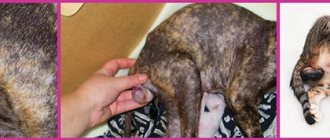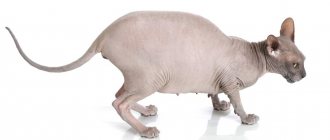How many months does a cat bear kittens?
A cat's pregnancy lasts about two months. The exact period depends on many factors and can range from 63 to 70 days. If a cat gives birth before the 60th day, then the offspring may not be viable. Walking around also indicates problems. If labor does not begin after the 70th day, a veterinarian examination is necessary.
Don’t despair, because even kittens that are premature or post-term for a few days can survive and grow up healthy. If the cat ate well during pregnancy and was in comfortable conditions, then a slight deviation from the due date (1-2 days) will not affect the health of the offspring.
If you don’t know exactly how many months a cat carries kittens and when labor begins, watch the animal. There are a number of signs by which you can determine whether a cat is pregnant and whether she will give birth soon.
Safe methods to increase cat fertility
When the cat is purebred and the owners are planning breeding, the question arises of increasing the birth rate. Designing the scale of offspring is not a simple matter, because it involves interfering with the natural processes of the body. The main task here is not to harm the animal.
Naturally, you can’t do without medications:
- Today's veterinary market offers a lot of homeopathic products that do not harm your beloved pet. Among them, Gamavit and Ovariovit received excellent recommendations. These drugs are designed to restore the function of the reproductive system, affecting the formation of a large number of eggs.
Ovariovit is a homeopathic drug for the prevention and treatment of ovarian dysfunction in cats, increases fertility, reduces the risk of false pregnancies
The stimulation process must begin long before mating. If pregnancy has taken place, all manipulations will be meaningless.
Signs of pregnancy in cats
In the early stages, it is not easy to determine a cat’s pregnancy, because there are no special laboratory tests for this. It remains to be guided by indirect signs that may indicate the onset of an interesting situation.
Decreased activity. For a few days after conception, your cat may sleep more than usual. Weakness, nausea and vomiting for several weeks after conception. Increased or, conversely, decreased appetite. After 3 weeks, the nipples will begin to turn pink. Changing taste preferences. Changes in character. Usually cats become more affectionate, but they can, on the contrary, become aggressive. In the fifth or sixth week, the belly will begin to increase. The cat's weight can increase by 1.5 times. Two weeks before giving birth, the cat begins searching for a nest.
Pregnancy can be accurately determined at a veterinary clinic using an ultrasound. The procedure can be carried out no earlier than two weeks after mating. On the 20th day, the veterinarian can determine pregnancy in cats using palpation. The duration of the period in which this procedure is possible is only a few days, since later the uterus will be filled with water and it will be impossible to feel the fruits.
Methods for determining the number of fruits
A responsible breeder, as a rule, wants to know exactly the number of future babies a pet will have. How to determine how many kittens a cat will have? Some experts claim that the number of future babies can be determined by the number of nipples the mother has. However, this method is not accurate. Feeling the cat's abdomen to determine the number of fetuses is an unsafe technique for the pet's health and is not informative. Even a veterinary specialist needs to be very highly qualified in order to accurately determine the number of future offspring in this way and not harm the babies and mother. Palpation is most often carried out on 20 - 21 days after mating or on the 49 - 55th day. These dates are due to the fact that after the 21st day the uterus is filled with amniotic fluid, making diagnosis much more difficult.
The safest and most informative method for the expectant mother is an ultrasound examination of the uterus. An ultrasound can be performed to determine the number of kittens starting from the 21st day after mating. By this period, you can determine the number of fetuses in the womb and listen to their heartbeat.
A responsible breeder is rightly puzzled by the question of how to find out how many kittens a cat will have. This allows him to competently approach issues of assistance during childbirth and solve the problem of selling young animals in advance. Knowledge of the causes and factors influencing multiple pregnancy, knowledge in the field of genetics will help you choose the right stud cat for your pet, follow the rules of feeding and keeping the animal during pregnancy.
Stages of pregnancy
We have already learned how many months a cat bears kittens. What else do you need to know about the interesting situation of your furry pet? Just as a woman’s pregnancy is divided into trimesters, so is pregnancy in cats divided into 5 stages.
The duration of the first stage is 20-25 days. The cat sleeps more, its appetite and mood change. The animal can become passive, affectionate, aggressive, capricious, etc. The tummy is not yet rounded, but the nipples begin to turn pink. The next period is the fourth week of cat pregnancy. The tummy is slightly rounded, because kittens are already 3-3.5 cm in size. At the fifth or sixth week, pregnancy is already clearly visible. The fruits descend into the abdominal cavity and the abdomen becomes significantly rounded. The fourth period of pregnancy in cats lasts from 42 to 50 days. At this time, accelerated development of embryos occurs. Their size is already 5-8 cm. The fur of the fruit begins to grow. Often the expectant mother loses her appetite at this stage. From day 51, the last stage of cat pregnancy begins. The fruits are already large in size and active; by placing your hand on the cat’s belly, you can feel them moving. As the birth approaches, the cat becomes restless and may experience urinary incontinence. A day before giving birth, the animal begins to search for a place for a nest.
Important questions for the breeder: how long does a cat give birth for the first time and then what affects the number?
Owners of domestic beauties are often interested in the question of how many kittens a cat gives birth to for the first time. This problem is relevant not only for breeders involved in breeding purebred animals. What determines the multiple births of an animal or, conversely, why one kitten is born - such questions are also of interest to owners of ordinary pets.
The question of the number of babies in the litter has practical significance for the owner of a pregnant female: it allows you to simplify obstetric care and have an idea in advance about how many babies need to be placed in good hands.
Many years of experience in keeping domestic cats indicates that the average pet living in favorable conditions gives birth to 4 to 6 kittens. Of course, this figure may change in one direction or another, but the deviation is insignificant.
It is not uncommon for a cat to give birth to 10 or even 15 live cubs per lamb, but this is rather an exception to the rule. It is difficult to guess how many kittens a cat can give birth to. Experienced breeders believe that the size of the offspring depends on the number of milk nipples the female has. To do this, you need to count them and subtract the number 2. This method of determination is not absolutely reliable, but can be adopted.
Physiologically, the size of the offspring is determined by the number of sites where fertilized eggs attach to the walls of the uterus, which in cats consists of two horns. Therefore, young and old females give birth to fewer kittens than animals at optimal reproductive age.
It is also known that street stray cats give birth to more babies at one time than prosperous, pampered domestic beauties. Scientists explain this fact by the weakening of the genetic apparatus in animals living in comfortable conditions. Street relatives are forced to leave behind more numerous offspring in order to preserve the cat family in an unfavorable habitat.
Many factors influence how many kittens a cat can give birth to:
- Age of the expectant mother. Firstborns most often give birth to 1 to 3 babies maximum. Fertility in an old animal decreases. After the age of seven, the pet will produce fewer cubs than a cat under the age of 6-7 years. The peak of multiple births (from 4 to 12 babies per lamb) occurs at the age of 3 to 6 years.
- Heredity. If females in a cat’s family have produced numerous offspring, then there is a high chance that the animal will also have multiple births.
- The reason why a cat gives birth to few kittens is often a hormonal imbalance, leading to a decrease in the synthesis of eggs ready for fertilization.
- Breed. There is a tendency: a purebred animal gives birth to fewer kittens than a purebred animal, and rarely produces more than 5 babies in one lamb.
- Animal weight. Obesity or malnutrition reduces the possibility of multiple offspring.
- Nutrition. If a cat does not receive complete proteins, including taurine, as well as vitamins and minerals, it may develop nutritional infertility or infertility. An inadequate diet leads to the fact that the animal’s defensive reaction to a deficiency of certain substances is the fertilization of a small number of eggs.
- The male also influences how many kittens a cat gives birth to. A sexually temperamental cat causes more eggs to be released during intercourse for fertilization. After all, as you know, ovulation in cats occurs during mating.
- The quality of a male's sperm also influences the partner's fertility.
- Chronic inflammatory processes in the reproductive sphere have a negative impact on reproductive function in general and may be the reason that the female gives birth to few cubs.
- The reason why a cat gave birth to one kitten may be prolonged and uncontrolled use of hormonal drugs (“Counter-Sex”, “Sex-Barrier” and the like). Hormone-based contraception seriously undermines the reproductive function of the animal, causing so-called hormonal stress in the body, which leads to the birth of 1 - 2 babies in the litter.
- Individual characteristics of the animal.
We suggest you familiarize yourself with: Which food is best for cats with sensitive digestion – Go food for cats, reviews from veterinarians and the official website, price and where to buy, composition for animals with sensitive digestion
Thus, the number of kittens per lambing is influenced by a variety of reasons and factors, which are not always possible to take into account. In addition, the number of babies changes with each lambing. As a rule, by the 6th year of an animal’s life, the female’s fertility reaches its maximum, and after the 7th year the number of kittens in the litter decreases.
Experienced owners have an idea of how many kittens a cat carries. The average duration of pregnancy is 59 - 64 days. Representatives of large and long-haired breeds bear babies longer - up to 70 days. Postmaturity has more negative consequences than giving birth prematurely. Therefore, if you suspect that pregnancy is prolonging, you should show the animal to a veterinarian.
The duration of pregnancy is influenced by various factors: nutrition and maintenance of the animal, health status, stress, individual characteristics. The number of developing fetuses also influences how long a cat carries kittens in her stomach. If there are 1 - 2 kittens in the womb, then the mother carries them longer than in the case of a large litter.
2 - 3 days before giving birth, the cat becomes restless and looks for a quiet and secluded place. By this time, the owner should prepare a cozy and clean nest for the future mother in a quiet, darkened room. Shortly before labor begins, the animal loses its appetite. When you press on the nipples, drops of colostrum appear. A characteristic sign of approaching labor is a decrease in body temperature to 37 C.
If the animal is healthy, then the birth takes place independently and the owner can only observe and, if necessary, unobtrusively provide assistance to the pet. In case of complications during labor, you should immediately seek help from a veterinarian.
There are several ways to find out how many kittens a cat will give birth to. Conventionally, they can be called physiological, folk and scientific methods.
- Physiological. The number of kittens depends on the number of places where fertilized eggs attach to the walls of the uterus.
- People's Experienced cat owners calculate the number of future offspring in a simple way. The number two is subtracted from the number of mammary glands in the female. This method does not give 100% results, but is still often used in practice.
- Scientific. Felinologists recommend checking the expectant mother with an ultrasound a week before the expected birth. Thus, it will be known exactly what kind of offspring to expect. Under no circumstances should you feel your cat's belly with your hands to find out how many kittens she will give birth to. Palpation can damage embryos and lead to psychological stress for the expectant mother.
Features of various breeds
Does it depend on the breed how many months a cat bears kittens? Yes, there is some dependence. It is believed that the longer the animal's fur, the longer the pregnancy lasts. Long-haired breeds give birth closer to the 70th day, and short-haired cats can lamb on the 53-60th day.
You should know that postmaturity is much more dangerous than premature birth. Post-term kittens are often sick. Slightly premature animals are weaker, but quickly gain strength with intensive feeding.
Reproduction problems
Adopting 10-12 kittens per year is problematic. Over the entire period of sexual activity, and cats can reproduce until they are very old, two hundred kittens will “make happy” all acquaintances and strangers, as well as join the ranks of ownerless street cats - a terrible fate.
That is why numerous shelters and funds for homeless animals, in addition to general treatment and maintenance measures, carry out castration. The general practice throughout the world is that all animals not used for breeding are sterilized!
Number of kittens and gestational age
Does how many months a cat carries kittens depend on their number? Yes, the pattern can be traced here too. The more babies a cat has, the shorter the gestation period will be. This rule especially applies to young animals.
A large number of kittens for a young mother is fraught with negative consequences for her health, and the risk of premature birth increases. Nature itself protects young cats from troubles - during the first birth, a young cat gives birth to only one to three kittens. A mature animal can give birth to up to six babies.
Is it possible to increase the number of kittens in a litter?
This question is usually of interest to breeders involved in breeding kittens for sale, since the expected profit depends on the number of offspring, as well as covering the financial resources spent on mating (treatment, testing, raising, feeding).
Depending on the regalia of the inseminating cat, the cost of mating can reach up to 10 thousand rubles. At the same time, owners of males are often not interested in the number of offspring. They receive money for mating, and the rest does not concern them. This position is fundamentally wrong: both parties should be interested in a good offspring. Before you give money for mating, ask:
- how often the cat is used;
- is he eating well? whether he has diseases of the genitourinary system;
- how many kittens are usually born from a male cat;
- Does the cat suffer from cryptorchidism?
To increase fertility, experts recommend injecting cats with the following drugs before breeding:
- Ovariovit: a homeopathic medicine that restores ovarian function, regulates the sexual cycle and increases fertility.
- Gamavit: anti-stress, immunostimulating drug, supports the vitality of the body, has a positive effect on eggs.
- Vitamin E: has a beneficial effect on the reproductive system, prevents infertility.
There is a special scheme designed for 10 days, which is often used for cats:
- Ovarium: 0.5 cc is administered subcutaneously once a day.
- Ortilin: 1 tablet twice a day.
- Ovariovit: 1 tablet 2 times a day.
- Vitamin E: 1 capsule twice a day.
- Gamavit: 1 cube per day subcutaneously.
- Catozal: 1 cube per day subcutaneously.
Treatment worsens signs of estrus and increases hormone levels. At the same time, the cat becomes more active and attractive to the inseminator.
Attention! Please consult your veterinarian before using this regimen for your cat.
Adviсe
Finally, some useful tips for owners of pregnant cats.
A pregnant cat should eat well. If you feed your cat dry food, switch to the same brand for pregnant and lactating cats. Do not self-medicate and do not give your pet any medications or vitamin supplements without a veterinarian’s prescription. If you have other cats, limit their contact with the pregnant woman. Animals in position love privacy. Limit walks outside, especially in the last stages of pregnancy, when the cat is especially vulnerable and cannot fend for itself. Also, giving birth on the street should not be allowed. Do not allow the animal to climb at heights. A cat with a big belly is clumsy, and falling is very dangerous. Prepare the nest for the upcoming birth. Find out in advance the phone numbers and addresses of the nearest veterinary clinics in case of complications. Don't forget how long a cat's pregnancy normally lasts, and consult a doctor if 70 days or more have passed since conception.
When can a cat become pregnant?
Pregnancy is a very important and responsible period in the life of both the cat itself and its owner, because pets are less adapted to life than their street relatives.
Only thanks to your guardianship and care will they be able to experience this moment easier and calmer, and for this, naturally, you need to prepare in advance. Of course, you can leave yourself in the hands of professionals, but many people prefer to give birth at home in order to experience the whole process on their own.
As soon as pregnancy is confirmed in a beloved pet, the owner has a lot of questions. This includes how long pregnancy lasts, how childbirth goes, and how many kittens a cat can give birth to at most, and many others. And you can find out the answers to all these questions on our website. In this article we will talk about exactly how many kittens a cat can give birth to.
If in women and cows it is 9 months, then in cats pregnancy lasts 9 weeks. Depending on the breed, physiological and age characteristics, it can “stretch” up to 72 days. Scientists have noticed that in short-haired beauties, pregnancy usually lasts 58-68 days, while long-haired and semi-long-haired cats can be in an interesting position for 63-72 days.
In addition, a lot depends on the number of kittens being carried. The more there are, the faster labor begins. But if a mother cat is carrying one or two kittens, then she can be pregnant for as long as possible. And such babies will be healthier than brothers from a multiple litter. But can a cat give birth to one kitten or will there necessarily be many of them?
Now let's move on to the most interesting part: how many kittens can a cat give birth to at most? Let's talk about several features that affect the number of newborns.
A cat is ready to become a mother for the first time at the age of 5 to 9 months, but this period may shift. There are many factors that influence an animal's reproductive process. Body size, breed, general health and even the length of daylight hours all matter in one way or another. As a result, the age of a cat for the first pregnancy can vary from 3.5 (that is, pregnancy occurs even in small kittens) to 18 months.
Readiness to mate is expressed by peculiar behavior: the cat becomes very restless, constantly demands attention, may sleep less and eat worse. In addition, a characteristic pose appears when the cat falls on its front paws, arches its lower back, rolls on the floor and purrs or meows invitingly.
Number of heats per year
Estrus in an animal is a natural and individual process for each individual. The duration of estrus and the frequency of cycles per year depend on a number of factors:
- hereditary characteristics;
- breed affiliation;
- complete nutrition;
- features of keeping (presence of a male);
- light mode.
The average duration of estrus is 1 - 2 weeks, sometimes the process can drag on for up to 3 weeks. The period consists of proestrus (preparation for mating). At this moment, the cat’s body is preparing for the upcoming fertilization: the external genitalia swell, the hormonal status and behavior of the pet changes, it becomes more affectionate and sociable.
After 1 - 3 days, the estrus (estrus) phase begins. This period is characterized by the characteristic behavior of the animal. The cat screams loudly, loses its appetite, tries to leave the room, leaves marks on furniture and objects, and takes a characteristic pose. If mating does not occur, this phase lasts 10 - 12 days. Then comes a period of calm (intersestrus), the animal’s behavior returns to normal.
The duration also depends on the breed. For example, in Maine Coons the phase takes 3 - 4 months, and in Abyssinians only 3 - 4 days.
In the event that estrus is empty, interestrus is significantly reduced, and the period between estrus can be only a few days. In this case, the animal may come into heat every 3 weeks. This greatly exhausts the pet.
The duration of the resting period is influenced by the length of daylight hours. Thus, in the autumn-winter period, hormonal activity fades and estrus becomes less frequent. In the spring-summer period, as the duration of daylight increases, the interval between heats decreases. However, in apartment conditions with artificial lighting, this factor is of little importance.











